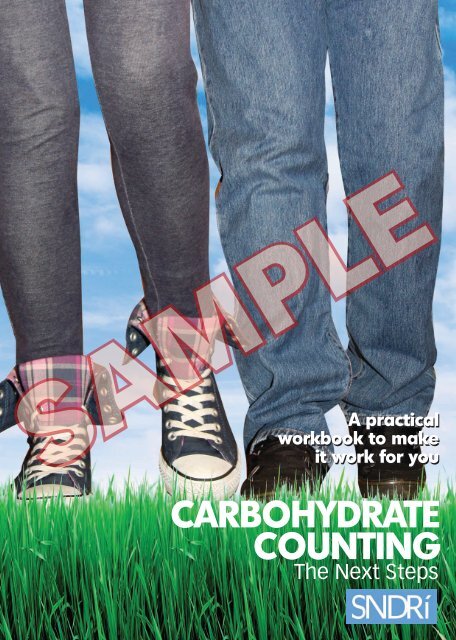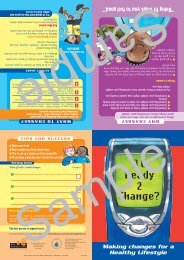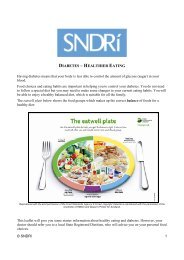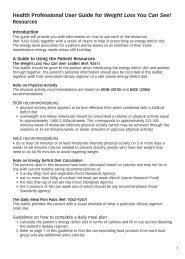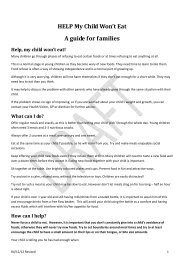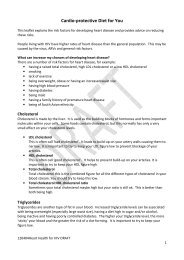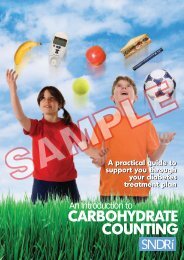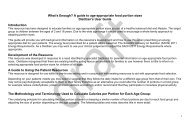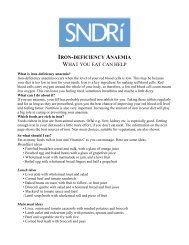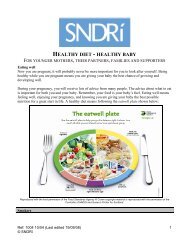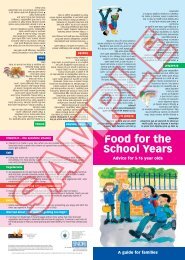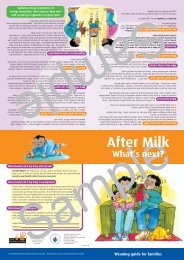Bolus Insulin - NDR-UK
Bolus Insulin - NDR-UK
Bolus Insulin - NDR-UK
You also want an ePaper? Increase the reach of your titles
YUMPU automatically turns print PDFs into web optimized ePapers that Google loves.
A practical<br />
workbook to make<br />
it work for you<br />
CARBOHYDRATE<br />
COUNTING<br />
The Next Steps
CARBOHYDRATE COUNTING<br />
THE NEXT STEPS<br />
A practical workbook to make it work for you<br />
C o n t e n t s<br />
• Basal <strong>Insulin</strong><br />
• <strong>Bolus</strong> <strong>Insulin</strong><br />
• How Do I Check my ICR?<br />
• Correcting High Blood Glucose<br />
• H y p o s<br />
• Exercise and A c t i v i t y<br />
• Sick Day Rules<br />
• Adjusting Your <strong>Bolus</strong> with a Flexible Diet<br />
• Different food types and your bolus<br />
• S n a c k s<br />
• S l e e p o v e r s, p a r t i e s, and eating out<br />
- Sleepovers<br />
- Pa r t i e s<br />
- Eating out<br />
•Timing Your <strong>Bolus</strong><br />
• Menus for a Flexible Life!<br />
p a g e<br />
1<br />
2<br />
5<br />
6<br />
10<br />
11<br />
13<br />
14<br />
14<br />
17<br />
17<br />
17<br />
18<br />
18<br />
19<br />
20<br />
G e n e ral information<br />
CHO counting<br />
B a s a l<br />
<strong>Bolus</strong> and ICR<br />
Variable factors that affect bolus needs Trends and testing<br />
Adjustments and corrections Trends and ∑
Now that you are familiar with carbohydrate counting and your treatment plan, you<br />
are ready to think about different aspects of your routine and lifestyle in more detail<br />
Basal <strong>Insulin</strong><br />
R e m e m b e r, your basal insulin is background insulin. You always need it to keep your glucose<br />
levels steady and to give you energy. Your diabetes team will work with you to agree your<br />
initial basal dose and help you check that it continues to be correct.<br />
If your basal insulin is correct, your blood glucose before you have anything to eat when you<br />
get up, should be similar to what it was when you went to bed. Monitor your results and look<br />
for patterns in your blood glucose increasing or decreasing overnight. You should also<br />
consider any other things that could affect your results such as:<br />
• the amount of activity you have done<br />
• eating dinner late<br />
• having a large bedtime snack without taking an extra bolus<br />
• having a bedtime snack later than normal.<br />
Look at David’s blood glucose results below and decide if the amount of basal insulin that he is<br />
taking is too little, too much or just right.<br />
Blood glucose (mmol/l)<br />
Day<br />
Before breakfast<br />
Before lunch Before evening meal<br />
Before bed<br />
During the night<br />
M o n<br />
1 4 . 9<br />
8 . 3<br />
Tu e s<br />
1 9 . 3<br />
8 . 5<br />
1 1 . 3<br />
We d<br />
1 5 . 7<br />
9 . 6<br />
T h u r s<br />
1 4 . 5<br />
1 0 . 5<br />
Fr i<br />
1 2 . 3<br />
8 . 9<br />
D a v i d ’s blood glucose results show his level is rising overnight. This may mean that he should<br />
increase his basal insulin.<br />
Fill in the table below and think about whether you are taking too little, too much or the right<br />
amount of basal insulin.<br />
Day<br />
M o n<br />
Tu e s<br />
We d<br />
T h u r s<br />
Fr i<br />
Blood glucose (mmol/l)<br />
Before breakfast Before lunch Before evening meal Before bed During the night<br />
Your diabetes team will work with you to agree your basal dose and to make any necessary<br />
a d j u s t m e n t s.<br />
1
<strong>Bolus</strong> <strong>Insulin</strong><br />
Remember bolus insulin is the rapid-acting insulin that you take with carbohydrate foods. Yo u r<br />
bolus depends on several things including how much carbohydrate is in your meals and<br />
s n a c k s.<br />
L e t ’s think about some examples to help you work out your bolus doses.<br />
Clare has had diabetes since she was six. Now she is 11 and has been using basal insulin<br />
once a day, with bolus insulin for meals for just over a year. She found it a lot of work at first,<br />
but with her family and diabetes team, she worked out her basal dose and her insulin to<br />
c a r b o h y d rate ratio (ICR). Clare and her family also spent a lot of time practicing how to work<br />
out the amount of carbohydrate in different foods and meals that she eats and enjoys. N o w<br />
Clare feels confident with her treatment plan and enjoys being able to adjust her insulin with<br />
her meals and routine.<br />
Like most of us, Clare has a usual routine of school and other activities. Thinking about some of<br />
the things that she does may help you to work out things for your own routine.<br />
Clare uses different ICRs throughout the day. Her breakfast ICR is 1 unit of insulin per 8g of<br />
carbohydrate (1:8), and her lunch and dinner ICRs are 1 unit of insulin per 10g of<br />
carbohydrate (1:10).<br />
Do you know your ICR?<br />
• My breakfast ICR is<br />
• My lunch ICR is<br />
• My dinner ICR is<br />
Look at how Clare has worked out how much carbohydrate is in her meals and how much<br />
bolus she should have with these meals. Try to complete the tables to work out the amount of<br />
c a r b o h y d rate in some of y o u r meals and how much bolus y o u should have.<br />
C l a r e ’s breakfast<br />
Large bowl of Cheerios<br />
(40g)<br />
and milk (150ml)<br />
Glass of orange juice<br />
( 1 5 0 m l )<br />
Total carbohydra t e<br />
Units of insulin<br />
Calculation<br />
75g CHO per 100g<br />
= 75g CHO ÷ 100g Cheerios<br />
= 0.75g CHO per gram Cheerios<br />
40 x 0.75 = 30g CHO<br />
5g CHO per 100ml milk<br />
= 0.05g CHO ÷ 100ml milk<br />
= 0.05 x 150 = 7.5g CHO<br />
12.5g CHO per 100 ml<br />
= 12.5g CHO ÷ 100ml orange juice<br />
= 0.125g CHO per ml<br />
= 0.125 x 150 = 18.75g CHO<br />
= 56.25g CHO<br />
ICR<br />
= 1:8 (1 unit per 8g CHO)<br />
= (56.25 ÷ 8) x 1<br />
= 7.03 units (round down to the nearest whole unit)<br />
30g<br />
7.5g<br />
18.75g<br />
56 .25g<br />
7 units<br />
2
My breakfast<br />
C a l c u l a t i o n<br />
Total carbohydra t e<br />
Units of insulin<br />
C l a r e ’s lunch<br />
1 pitta bread with<br />
c h e e s e, chutney and<br />
t o m a t o<br />
1 carton orange juice<br />
( 2 0 0 m l )<br />
Packet crisps (25g)<br />
P e a r<br />
Total carbohydra t e<br />
Units of insulin<br />
C a l c u l a t i o n<br />
Label says 30g CHO per pitta<br />
No CHO in cheese or tomato<br />
Label says 5g CHO in a spoon of chutney<br />
Label says 20g CHO per carton<br />
Label says 15g CHO per packet<br />
Food tables says 10g CHO<br />
35 + 20 + 15 + 10 = 80g CHO<br />
ICR = 1:10 (1 unit per 10g CHO)<br />
= (80 ÷ 10) x 1<br />
= 8 units<br />
35 g<br />
20 g<br />
15 g<br />
10 g<br />
80 g<br />
8 units<br />
My lunch<br />
C a l c u l a t i o n<br />
Total carbohydra t e<br />
Units of insulin<br />
3
C l a r e ’s dinner<br />
Roast chicken with<br />
baked potato (155g) and<br />
b r o c c o l i<br />
Fruit corner yoghurt<br />
Glass of sugar- f r e e<br />
s q u a s h<br />
Total carbohydra t e<br />
Units of insulin<br />
C a l c u l a t i o n<br />
Food tables say:<br />
- no CHO in chicken or bro c c o l i<br />
- CHO table says 25g in 100g baked potato with skin<br />
= (25 ÷ 100) x 155<br />
= 38.75g CHO<br />
Label says 29g CHO per pot<br />
Label says 0g<br />
38.75 + 29 = 67.75g CHO<br />
ICR = 1:10 (1 unit per 10 g CHO)<br />
= (67.75 ÷ 10) x 1<br />
= 6.775 units (round up to the nearest whole unit)<br />
38.75 g<br />
29 g<br />
0<br />
67.75g<br />
7 units<br />
My dinner<br />
C a l c u l a t i o n<br />
Total carbohydra t e<br />
4<br />
Units of insulin
How Do I Check my ICR is Right?<br />
As you become older, change your routine and your lifestyle, your ICR can change. It is<br />
important to check if your ICR is still right. The best way to do this is to check your blood<br />
glucose (BG) regularly.<br />
<strong>Bolus</strong> insulin lasts for a short time. Test your blood glucose before your bolus and<br />
hours after to check if your ICR is correct. This is sometimes called taking paired readings.<br />
To check if your ICR is right:<br />
1 .Take a note of your blood glucose just before your meal.<br />
2 .Calculate the carbohydrate in your meal and use your ICR to work out your bolus, t h e n<br />
take it as normal.<br />
3 . After hours, test your blood glucose again.<br />
If your blood glucose is within mmol/l of your pre-meal result, your ICR is correct.<br />
If your blood glucose is more than mmol/l higher or lower than your pre-meal<br />
result, you may need to change your ICR.<br />
4 . Look for patterns in your blood glucose results. Do not make changes to your ICR based<br />
on one set of paired readings.<br />
Clare has checked her basal insulin and knows it is correct. Now she wants to check her ICR.<br />
D a t e<br />
07/11<br />
ICR = 1:10<br />
BG before food<br />
C H O<br />
<strong>Bolus</strong> insulin<br />
BG 2 hours after food<br />
B r e a k f a s t<br />
5 . 2<br />
50 g<br />
5<br />
6 . 1<br />
C l a r e ’s results show that her blood glucose is steady and within her target range before her<br />
breakfast and 2 hours after she has eaten. T h e r e f o r e, her ICR is correct.<br />
Now check your ICR.<br />
D a t e ICR =<br />
BG before food<br />
C H O<br />
<strong>Bolus</strong> insulin<br />
BG hours after food<br />
B r e a k f a s t<br />
If your blood glucose tends to be higher, your ICR may need to decrease.<br />
If your blood glucose is lower, your ICR may need to increase.<br />
Before you make any changes to your ICR:<br />
• check that you are calculating the carbohydrate of your meal correctly<br />
• check that you are calculating your bolus correctly<br />
• check patterns in your blood glucose over a few days, and discuss changes with your<br />
diabetes team.<br />
R e m e m b e r:<br />
•You always need your basal insulin. Check your dose by monitoring your blood glucose<br />
before you go to bed and when you get up – your dose is correct if your results are similar.<br />
• <strong>Bolus</strong> insulin only lasts for a short time. Use your ICR to work out your bolus for meals and<br />
snacks that contain carbohydra t e.<br />
• Your ICR can change with age, routine and lifestyle. Check it is right by monitoring your blood<br />
glucose and checking your carbohydrate and bolus calculations.<br />
5 5
Correcting High Blood Glucose<br />
Sometimes your blood glucose level can become higher than your target. Your diabetes team<br />
will provide you with guidance about if, when and how you should use a correction dose of<br />
bolus insulin. You should normally only use this with your meal bolus.<br />
Calculating your correction factor (CF) will help you to work out necessary correction boluses.<br />
Your C F is the amount that 1 unit of insulin will reduce your blood glucose. A useful tool<br />
to work out your C F is the 100 rule.<br />
The 100 rule:<br />
1 . Add up your t y p i c a l total daily insulin<br />
(basal and bolus).<br />
2 . Divide 100 by this amount (100 ÷ total<br />
i n s u l i n ) .<br />
3 . This is your CF.<br />
For example:<br />
Charlie normally has 22 units of basal insulin<br />
and 5 bolus units with breakfast and lunch,<br />
and 8 units with dinner.<br />
1 . C h a r l i e ’s daily insulin<br />
=<br />
=<br />
22 + 5 + 5 + 8 = 40 units<br />
2 . C h a r l i e ’s CF<br />
100 ÷ 40 = 2.5<br />
3 . Charlie would use 1 unit of bolus to<br />
reduce his blood glucose by 2.5mmol/l.<br />
Use the space below to work out your correction factor.<br />
6<br />
6
C h a r l i e ’s target blood glucose is 4-7mmol/l. Look at how he works out his correction bolus to<br />
help you calculate your correction bolus if your blood glucose is above your target ra n g e.<br />
1 . S u b t ract your target blood glucose from<br />
your current level to work out how much<br />
it needs to fall.<br />
2 . Calculate your CF.<br />
3 . Divide your desired fall by your CF.<br />
For example:<br />
Charlie tests his blood glucose before his<br />
m e a l . It is 17mmol/l, so he has to have a<br />
correction dose with his meal bolus.<br />
1 . C h a r l i e ’s blood glucose needs to fall into<br />
his target ra n g e :<br />
17 - 7 = 10mmol/l<br />
2 . C h a r l i e ’s CF = 100 ÷ 40 = 2.5<br />
3 . C h a r l i e ’s correction bolus dose is:<br />
10 ÷ 2.5 = 4 units<br />
Charlie should have a 4 unit correction bolus with his meal bolus. H e should also continue to<br />
check his blood glucose regularly to make sure that the correction bolus is working.<br />
Use the space below to work out how you would correct your blood glucose if it was<br />
1 2 . 5 m m o l / l .<br />
7
Try this again. This time work out how you would correct your blood glucose if it was<br />
1 8 . 5 m m o l / l .<br />
It is important to correct high blood glucose. H o w e v e r, if you regularly have to take correction<br />
b o l u s e s, you may need to change your ICR or your basal dose. Discuss this with your diabetes<br />
t e a m .<br />
Once you know your CF and how much your blood glucose needs to fall, you can use the<br />
correction bolus calculator below to find your correction bolus. Read along the bottom<br />
( o range) line to your CF, then up the side (black) to the amount that your blood glucose needs<br />
to fall. Your correction bolus is at the point where the line meet.<br />
If your insulin pen has half units, round to the nearest half unit; if it only has whole units, round to the nearest<br />
whole unit.<br />
Correction <strong>Bolus</strong> C a l c u l a t o r<br />
Reduction in blood glucose required (mmol/l)<br />
10<br />
9.5<br />
9.0<br />
8.5<br />
8.0<br />
7.5<br />
7.0<br />
6.5<br />
6.0<br />
5.5<br />
5.0<br />
4.5<br />
4.0<br />
3.5<br />
3.0<br />
2.5<br />
2.0<br />
1.5<br />
1.0<br />
0.5<br />
0<br />
20 10 7 5 4 3 3 2.5<br />
19 9.5 6.5 5 4 3 2.5 2.5<br />
18 9 6 4.5 3.5 3 2.5 2<br />
17 8.5 5.5 4.5 3.5 3 2.5 2<br />
16 8 5 4 3 2.5 2 2<br />
15 7.5 5 4 3 2.5 2 2<br />
14 7 4.5 3.5 3 2 2 2<br />
13 6.5 4.5 3.5 2.5 2 2 1.5<br />
12 6 4 3 2.5 2 1.5 1.5<br />
11 5.5 3.5 3 2 2 1.5 1.5<br />
10 5 3 2.5 2 1.5 1.5 1<br />
9 4.5 3 2.5 2 1.5 1.5 1<br />
8 4 2.5 2 1.5 1 1 1<br />
7 3.5 2.5 2 1.5 1 1 1<br />
6 3 2 1.5 1 1 1 0.5<br />
5 2.5 1.5 1.5 1 1 0.5 0.5<br />
4 2 1.5 1 1 0.5 0.5 0.5<br />
3 1.5 1 1 0.5 0.5 0.5 0.5<br />
2 1 0.5 0.5 0.5 0 0 0<br />
1 0.5 0.5 0.5 0 0 0 0<br />
0.5 1.0 1.5 2.0 2.5 3.0 3.5 4.0<br />
8<br />
C F<br />
(The amount one bolus unit will reduce<br />
my blood glucose by (mmol/l))
For example:<br />
• Amy’s CF is 2.0.<br />
• Her target blood glucose is 4.0 to 7.0mmol/l.<br />
• She is about to have her lunch and has tested her blood glucose. It is 12.5mmol/l.<br />
• She needs to reduce her blood glucose by at least 5.5 (12.5 - 7 = 5.5mmol/l).<br />
• She checks the correction calculator by reading along the bottom (orange) to 2 and up the<br />
side (black) to 5.5mmol/l.<br />
• Amy should have the correction bolus noted at the point where the lines meet – 3 units.<br />
Correction <strong>Bolus</strong> C a l c u l a t o r<br />
Reduction in blood glucose required (mmol/l)<br />
10<br />
9.5<br />
9.0<br />
8.5<br />
8.0<br />
7.5<br />
7.0<br />
6.5<br />
6.0<br />
5.5<br />
5.0<br />
4.5<br />
4.0<br />
3.5<br />
3.0<br />
2.5<br />
2.0<br />
1.5<br />
1.0<br />
0.5<br />
0<br />
20 10 7 5 4 3 3 2.5<br />
19 9.5 6.5 5 4 3 2.5 2.5<br />
18 9 6 4.5 3.5 3 2.5 2<br />
17 8.5 5.5 4.5 3.5 3 2.5 2<br />
16 8 5 4 3 2.5 2 2<br />
15 7.5 5 4 3 2.5 2 2<br />
14 7 4.5 3.5 3 2 2 2<br />
13 6.5 4.5 3.5 2.5 2 2 1.5<br />
12 6 4 3 2.5 2 1.5 1.5<br />
11 5.5 3.5 3 2 2 1.5 1.5<br />
10 5 3 2.5 2 1.5 1.5 1<br />
9 4.5 3 2.5 2 1.5 1.5 1<br />
8 4 2.5 2 1.5 1 1 1<br />
7 3.5 2.5 2 1.5 1 1 1<br />
6 3 2 1.5 1 1 1 0.5<br />
5 2.5 1.5 1.5 1 1 0.5 0.5<br />
4 2 1.5 1 1 0.5 0.5 0.5<br />
3 1.5 1.0 1 0.5 0.5 0.5 0.5<br />
2 1 0.5 0.5 0.5 0 0 0<br />
1 0.5 0.5 0.5 0 0 0 0<br />
0.5 1.0 1.5 2.0 2.5 3.0 3.5 4.0<br />
C F<br />
(The amount one bolus unit will reduce my blood glucose by (mmol/l))<br />
• Amy calculates the carbohydrate in her lunch. It is 50g.<br />
• Her ICR is 1:10, so she needs a meal bolus of 5 units ((50 ÷ 10) x 1= 5).<br />
• She needs to take her meal bolus plus her correction bolus.<br />
This is 8 units in total (3 + 5 = 8 units).<br />
R e m e m b e r:<br />
• You can bring high blood glucose back into target with a correction bolus of insulin.<br />
• Your correction factor (CF) is how much 1 unit of bolus insulin will reduce your blood glucose.<br />
• Only take a correction bolus with your meal/snack bolus.<br />
9 9
H y p o s<br />
Using your treatment plan with carbohydrate counting can help to reduce hypos, but you still<br />
need to know what to do if your blood glucose falls below your target level.<br />
Your diabetes team will provide you with more information to help you and your family prevent<br />
and treat hypos.<br />
Think about the situations below and consider what you would do.<br />
What blood glucose would mean that James is hypo?<br />
How might he feel if his blood glucose is low?<br />
What should he do if his blood glucose is low?<br />
How do you feel when your blood glucose is low?<br />
What do you do when your blood glucose is low?<br />
When you have a hypo:<br />
• Stop what you are doing and take 5-15g of fast-acting carbohydrate such as Glucotabs,<br />
Lucozade or sugary drinks like cola or lemonade.<br />
• Wait 10-15 minutes. If possible, test your blood glucose level. If you are still hypo have<br />
more sugary carbohydrate.<br />
• Once your blood glucose is over 4mmol/l have a slower-acting carbohydrate snack such as<br />
f r u i t , plain biscuit or cereal bar or if it is mealtime, have your meal as normal.<br />
Your diabetes team will provide more information about hypos.<br />
10
Exercise and A c t i v i t y<br />
When you are active, the insulin in your body will affect your blood glucose. For example, t h e<br />
hypo risk increases when exercising just after a bolus.<br />
Being aware of your blood glucose level, c a r b o h y d rate and how your basal and bolus insulin<br />
w o r k , will help you enjoy exercise and sport. Try to test your blood glucose before, during and<br />
after exercise. Use your results to help you plan in the future.<br />
For example, Aisha has a snack before going to judo after school on Tu e s d a y s. She always has<br />
a small carton of fruit juice in her bag, checks her blood glucose before the class and carries<br />
glucose tablets with her.<br />
Before last week’s class, A i s h a ’s blood glucose was 9.6mmol/l. She had a snack with about<br />
30g of carbohydrate and didn’t take a snack bolus.<br />
The class takes an hour. After the class, A i s h a ’s blood glucose was 15.3mmol/l.<br />
What should she do this week about:<br />
…a snack?<br />
…her insulin?<br />
…testing her blood glucose?<br />
W h y ?<br />
…is there anything that she should look out for later in the day? What might help her to keep<br />
her blood glucose well controlled during and after judo?<br />
11
Think about your week and the things that you do<br />
So far you have learned how to keep your blood glucose in your target range by carbohydra t e<br />
counting and adjusting your bolus insulin. Now you are ready to develop these skills further.<br />
This will help you to keep good blood glucose control with daily changes in your routine.<br />
• Do you go to any after school activities?<br />
• Do any of these mean you are more active or have your meals at different times?<br />
• Do you need to adjust your insulin with exercise?<br />
Everyone reacts differently to exercise. You may find you need to change your bolus insulin<br />
dose depending on the type and timing of your activities. Ask your diabetes team about this.<br />
Note your typical routine in the table below. Think about how you juggle your activities like<br />
c l u b s, gym or PE with insulin, snacks and meals.<br />
Activities and<br />
t i m e s<br />
Snacks and<br />
meal times<br />
What I will do to keep my blood<br />
glucose in target range.<br />
M o n d a y<br />
Tu e s d a y<br />
We d n e s d a y<br />
T h u r s d a y<br />
F r i d a y<br />
S a t u r d a y<br />
S u n d a y<br />
If there are any things that you unsure about then discuss these with your diabetes team.<br />
12<br />
12
Sick Day Rules<br />
U n f o r t u n a t e l y, everyone becomes unwell at some point. When you have diabetes, you get<br />
c o l d s, sore throats, tummy bugs just like all other people. H o w e v e r, you need to manage your<br />
diabetes during your illness.<br />
Your diabetes team will provide sick day guidelines with more information on how to adjust<br />
your basal and bolus doses depending on your symptoms.<br />
R e m e m b e r:<br />
• Always take your basal insulin, even if you cannot eat.<br />
• Check your blood glucose regularly and try to keep your levels in your target ra n g e.<br />
• If your eating has changed or your blood glucose needs to be corrected, you may need to<br />
adjust your basal and bolus insulin.<br />
• Always check for ketones and follow your sick day guidelines.<br />
Use the space below to note y o u r sick day rules.<br />
13
Adjusting your <strong>Bolus</strong> with a Flexible Diet<br />
Now that you’re learning more about your treatment plan, think about the next steps to help<br />
you take greater control. This can make taking part in activities easier and more enjoyable.<br />
Different food types and your bolus<br />
Different foods will affect your blood glucose differently. The rate of their digestion will affect<br />
how your blood glucose will respond to your bolus and the carbohydrate in meals and snacks.<br />
Rate of digestion<br />
Quick<br />
Blood Glucose Level<br />
Medium<br />
Slow<br />
0 1 2<br />
When you are working out how much bolus insulin to take, it is important to think about:<br />
• the amount of carbohydrate in the food you eat<br />
a n d<br />
• how quickly the carbohydrate is digested.<br />
This may not change the a m o u n t of insulin you need, but may change w h e n you take it.<br />
The main factors that affect the rate of food’s digestion are:<br />
• F i b r e<br />
Having more fibre is generally a healthy option.<br />
Some high-fibre foods are digested slowly<br />
and release glucose into the blood slowly.<br />
High-fibre foods include:<br />
- pulses<br />
- wholegrain bread<br />
- whole wheat breakfast cereals<br />
- meals containing a lot of these<br />
foods, for example lentil soup.<br />
Time (hours)<br />
14
• Glycaemic index (GI)<br />
The glycaemic index (GI) is a scale from 1 to 100 that is used to measure how quickly<br />
foods that contain carbohydrate raise blood glucose levels.<br />
- Individual foods with high GI values will raise your blood glucose level quickly.<br />
- Individual foods with low GI values will raise your blood glucose more slowly.<br />
H o w e v e r, you usually eat combinations of foods that combine to give a different GI value<br />
for your whole meal or snack. R e m e m b e r, it is the total amount of carbohydrate eaten<br />
has the main effect on your blood glucose.<br />
• Fat content<br />
Fat can slow down your digestion so carbohydrate from high-fat meals may be released<br />
slowly into your blood. Meals which tend to be high-fat include:<br />
- foods cooked in batter or using a lot of fat such as fish and chips, crispy duck,<br />
e n c h i l a d a s, pastry dishes like pies, pasties and sausage rolls<br />
- foods made with lots of cream or cheese such as korma, m a s a l a , c a r b o n a ra , macaroni<br />
c h e e s e, four cheese pizza<br />
- fatty meats and meat products such as burgers, b a c o n , p â t é .<br />
When carbohydrate from meals is digested slowly, a single insulin bolus may reduce your<br />
blood glucose too quickly and cause you to hypo. H o w e v e r, as you slowly digest your meal<br />
and gradually release glucose, your blood glucose may become high as your insulin begins to<br />
run out.<br />
To help you to spot trends in the impact of different foods, monitor your blood glucose and<br />
the foods that you eat. Patterns may become obvious helping you to decide if you need to<br />
change the timing or the amount of bolus you require. Speak to your diabetes team for<br />
more guidance.<br />
To try and prevent your blood glucose falling and rising with meals that slowly release their<br />
c a r b o h y d ra t e, it can be useful to alter how you take your bolus. Two options are possible:<br />
• delay your bolus insulin for a short time after your meal<br />
o r<br />
• split your bolus into two injections – take one with your meal and one shortly after.<br />
Discuss this with your diabetes team.<br />
P ractice and test your blood glucose regularly. This will help you decide which method works<br />
best for you with different meals and situations.<br />
15
Think about the foods in the list below:<br />
• baked potato with tuna and sweetcorn<br />
• fish and chips<br />
• fl a p j a c k<br />
• milk chocolate<br />
• pizza with ham and cheese.<br />
How quickly do you think each will be digested?<br />
What do you think affects their rate of digestion?<br />
What adjustments would you make to the amount or the timing of the bolus for these foods?<br />
Now think about meals and snacks that you enjoy. How quickly will they be digested? W r i t e<br />
some down under the quick, medium or slow headings in the table below. If you’re not sure,<br />
think about them with your dietitian.<br />
Q u i c k M e d i u m S l o w<br />
R e m e m b e r:<br />
• The main factors that affect the rate of food’s digestion are fibre, GI and fat.<br />
• The total amount of carbohydrate eaten has the main effect on your blood glucose.<br />
• Monitor your blood glucose and the foods that you eat to spot patterns in the rate that<br />
you digest different foods.<br />
16
S n a c k s<br />
Your treatment plan gives you flexibility with snacks. You may even choose not to have<br />
s n a c k s. If it is a snack containing more than g carbohydra t e, you may need to have an<br />
e x t ra bolus. Your diabetes team will discuss this with you.<br />
L e t ’s look at what Lee does in the situation below:<br />
Lee doesn’t usually take bolus insulin for snacks with 20g or less carbohydrate in it.<br />
Lee likes to have a snack on the way home from school. On Fr i d a y, he goes out with friends after<br />
school and has a milkshake and a muffin. Lee checks the fast food labels and works out that<br />
this snack has 90g of carbohydra t e.<br />
Do you think he should take an extra bolus for this snack?<br />
What snacks do you have that may need an extra bolus?<br />
S l e e p o v e r s, p a r t i e s, and eating out<br />
Your treatment plan helps to make sleepovers, p a r t i e s, and eating out easier to manage. T h i s<br />
lets you enjoy all the fun with your friends and family.<br />
Adjust your bolus with different foods, meal times and bedtime, and always take your basal<br />
insulin at the same time. Depending how active or excited you are, you may have to take a<br />
little less basal than normal. Discuss this with your diabetes team.<br />
S l e e p o v e r s<br />
Staying overnight at a friend’s house should be fun.<br />
Top tips for a fun sleepover:<br />
• Take your basal insulin at the same time.<br />
• Think about any extra snacks you have. If these have more carbohydrate than your usual<br />
bedtime snack, you may need to take an extra bolus. Remember to check your blood<br />
glucose and think about how active you’ve been. Your diabetes team will provide more<br />
i n f o r m a t i o n .<br />
• Test your blood glucose the next morning and take your bolus as usual with breakfast.<br />
17
Pa r t i e s<br />
There are lots of different parties – a friend’s house with games and lots of food, the cinema<br />
with ice cream and popcorn, skateboarding and cycling then out for pizza or a disco with lots<br />
of dancing.<br />
Adjust your insulin depending on how active or excited you are and what food you have.<br />
Top tips to enjoy the party:<br />
• If you’ve been more active than usual, you may need to take less insulin with the next<br />
m e a l , or if the party was in the evening, you may need a bigger bedtime snack than<br />
n o r m a l .<br />
• If the meals and snacks have more carbohydrate than your normal foods, adjust your<br />
insulin and check your blood glucose when you get home. If it is high, take a correction<br />
bolus with your next meal.<br />
Eating out<br />
<strong>Insulin</strong> dose adjustment helps to make going out easy and enjoyable. Yo u can have your<br />
meal at any time, just remember to count the carbohydrate in the foods you choose and<br />
calculate your bolus insulin using your ICR.<br />
Top tips for eating out:<br />
• Wait until your food is served until you take your bolus.<br />
Seeing your food will help you work out how much carbohydrate is in your meal so you<br />
will be able to calculate the right bolus to take.<br />
• Split your bolus – take one for your main course then decide if you want dessert. Take a<br />
second bolus with your dessert so that you can give yourself the right amount of insulin<br />
for it to.<br />
• If you’re unsure how much you are going to eat, it may be better to take your bolus after<br />
the meal. Discuss this with your diabetes team.<br />
18
Timing your <strong>Bolus</strong><br />
You probably take your bolus as part of a standard routine of school, activities and regular<br />
meal times and food choices. H o w e v e r, when you are away from home or on holiday this is<br />
likely to change.<br />
Think about the situations below.<br />
• When would you take your bolus?<br />
• Are there any other things you would think about and do?<br />
1 . You’re out with a friend and their family for pizza. You have ordered a cheese and<br />
mushroom pizza and are planning to have an ice cream for pudding.<br />
2.a) You’re visiting family and staying for lunch. You know this three course meal has much<br />
more carbohydrate than you usually have at lunch.<br />
b) People get chatting and things get delayed.<br />
3 . You’re up very early because you are going on holiday. I t ’s too early to have your usual<br />
breakfast but you decide to have some toast and fruit juice. You will have a chance to eat<br />
something else later.<br />
Remember this is only a guide. Everyone is different so keep a note of what you do each time.<br />
This will help you to keep good control of your diabetes and enjoy all the fun with your friends<br />
and family.<br />
19
20<br />
Menus for a Flexible Life!<br />
An everyday menu and diary - - - think about your typical daily routine.<br />
- What do you eat?<br />
- When do you normally get up, go to bed, have your meals and snacks?<br />
- What activities do you do?<br />
- How will you manage your injections today?
A menu and diary for a sleepover at your best friend’s house.<br />
- What do you eat?<br />
- When do you normally get up, go to bed, have your meals and snacks?<br />
- What activities do you do?<br />
- How will you manage your injections today?<br />
21
22<br />
A daily menu and diary for a day out with friends.<br />
- What do you eat?<br />
- When do you normally get up, go to bed, have your meals and snacks?<br />
- What activities do you do?<br />
- How will you manage your injections today?
A menu and diary for your holiday routine<br />
- What do you eat?<br />
- When do you normally get up, go to bed, have your meals and snacks?<br />
- What activities do you do?<br />
- How will you manage your injections today?<br />
23
24<br />
A menu and diary for a special occasion (Christmas/birthday)<br />
- What do you eat?<br />
- When do you normally get up, go to bed, have your meals and snacks?<br />
- What activities do you do?<br />
- How will you manage your injections today?
Are there any things that you do that you would like to change and do differently?<br />
Write these down or talk to your diabetes team about them. Together you can try to work out<br />
a different way to do things that will make you happier.<br />
25
This information has been produced for S<strong>NDR</strong>í by Registered Dietitians and other relevant health professionals. At the time of publication the information contained<br />
within the leaflet was, to the best of our knowledge, correct and up-to-date. Always consult a suitably qualified dietitian and/or your GP on health problems.<br />
S<strong>NDR</strong>í cannot be held responsible for how clients/patients interpret and use the information within this resource.<br />
© S<strong>NDR</strong>í, First Published 12/10, Ref 9226<br />
Reviewed XX/XX, XX/XX<br />
Visit www.gcu.ac.uk/sndri for ordering information and enquiries<br />
Hosted by Glasgow Caledonian University and part funded by the<br />
Scottish Government and Welsh Assembly Government.<br />
A Registered Dietitians’ project, in partnership with other agencies.


